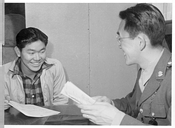 Beginning
in February 1943 the WRA and the War Department jointly began
registering all adults in the internment camps. Both used the
same form entitled "Application for Leave Clearance."
The War Department wished to register all male citizens of draft
age even though Japanese-Americans were not eligible to be drafted
until January 1944. The WRA wanted a list of adults in order
to relocate the Japanese more quickly back into American society.
The registration further served the military by receiving applications
from volunteers to serve in an all Japanese-American combat team.
Beginning
in February 1943 the WRA and the War Department jointly began
registering all adults in the internment camps. Both used the
same form entitled "Application for Leave Clearance."
The War Department wished to register all male citizens of draft
age even though Japanese-Americans were not eligible to be drafted
until January 1944. The WRA wanted a list of adults in order
to relocate the Japanese more quickly back into American society.
The registration further served the military by receiving applications
from volunteers to serve in an all Japanese-American combat team.
The main function of the questionnaire was to measure the loyalty of the Japanese. Two questions were designed to achieve this goal:
Question 27: Are you willing to serve in the armed forces of the United States on combat duty, wherever ordered?
Question 28: Will you swear unqualified allegiance to the United States of America and faithfully defend the United States from any and all attacks by foreign and domestic forces, and forswear any form of allegiance or disobedience to the Japanese Emperor, or any other foreign government, power, or organization (Williams and Coleman 1992: 63)?
The questions created many uncertainties for the evacuees. Answering "yes" to Question 28, for the Issei, would leave the Issei without a country. The Nisei were fearful of answering "yes" to Question 28 for it might imply they had previously been loyal to the Emperor of Japan.
Other respondents answered "no" to both questions as a means of protest. These evacuees became known as "No-No Boys." Due to the confusion over Question 28 it was eventually changed for the Issei to be read as follows:
Will you swear to abide by the laws of the United States and to take no action which would in anyway interfere with the war effort of the United States (Williams and Coleman 1992: 63)?
Later the form was entitled "Information for Leave Clearance."
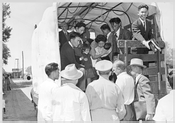 Using the answers to the loyalty
questions, officials began holding segregation hearings at Amache
on July 10, 1943. As a result of the hearings 125 evacuees at
Amache were declared disloyal (Holsinger
1960: 63). The decision in Washington was to segregate all
of the "disloyals" to the Tule Lake internment camp
in California. Tule Lake eventually became the largest internment
camp with 18,000 "disloyals." It further became known
for its violence, confrontations, and renunciation of citizenships.
Using the answers to the loyalty
questions, officials began holding segregation hearings at Amache
on July 10, 1943. As a result of the hearings 125 evacuees at
Amache were declared disloyal (Holsinger
1960: 63). The decision in Washington was to segregate all
of the "disloyals" to the Tule Lake internment camp
in California. Tule Lake eventually became the largest internment
camp with 18,000 "disloyals." It further became known
for its violence, confrontations, and renunciation of citizenships.
On September 16, 1943 the small group of "disloyals"
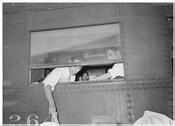 from Amache left on a train for
Tule Lake. On that same day the first train of "loyals"
from Tule Lake arrived at Amache. Eventually 1,040 evacuees
from Tule Lake relocated to Amache (Holsinger
1960: 64). The newly arrived evacuees created a slight uproar
in Amache. Director Lindley said:
from Amache left on a train for
Tule Lake. On that same day the first train of "loyals"
from Tule Lake arrived at Amache. Eventually 1,040 evacuees
from Tule Lake relocated to Amache (Holsinger
1960: 64). The newly arrived evacuees created a slight uproar
in Amache. Director Lindley said:
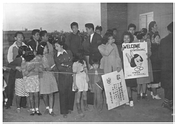 Although some good people were
received from Tule Lake, the effect of transfer on center life
was in general adverse. The Tuleans were about a year behind
the other residents of the center in their thinking; they were
still resentful and constantly harped on the wrongs
of the evacuation, which most of the other residents had
come to treat as water over the dam. Some leadership was developed
among this Tule Lake crowd, most of it bad (quoted
in Holsinger 1960: 64).
Although some good people were
received from Tule Lake, the effect of transfer on center life
was in general adverse. The Tuleans were about a year behind
the other residents of the center in their thinking; they were
still resentful and constantly harped on the wrongs
of the evacuation, which most of the other residents had
come to treat as water over the dam. Some leadership was developed
among this Tule Lake crowd, most of it bad (quoted
in Holsinger 1960: 64).
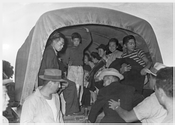 Eventually camp life returned
to normal at Amache
Eventually camp life returned
to normal at Amache 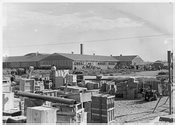 although
leaders among the Tule Lake evacuees eventually began to dominate
the Community Council. A rift was created between it and the
administration. "The Council began to oppose the officials
in the camp in every way that they could, making it hard for
Lindley and his staff to carry on the procedure of relocation
with which they had made such headway before the arrival of the
the California evacuees (Holsinger
1960: 64).
although
leaders among the Tule Lake evacuees eventually began to dominate
the Community Council. A rift was created between it and the
administration. "The Council began to oppose the officials
in the camp in every way that they could, making it hard for
Lindley and his staff to carry on the procedure of relocation
with which they had made such headway before the arrival of the
the California evacuees (Holsinger
1960: 64).